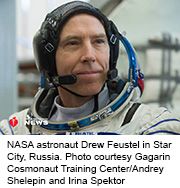- Navigating Your Midlife Crisis: Embracing New Possibilities
- City Raccoons Showing Signs of Domestication
- Mapping the Exposome: Science Broadens Focus to Environmental Disease Triggers
- One Week Less on Social Media Linked to Better Mental Health
- Your Brain Changes in Stages as You Age, Study Finds
- Some Suicide Victims Show No Typical Warning Signs, Study Finds
- ByHeart Formula Faces Lawsuits After Babies Sickened With Botulism
- Switch to Vegan Diet Could Cut Your Greenhouse Gas Emissions in Half
- Regular Bedtime Does Wonders for Blood Pressure
- Dining Alone Could Mean Worse Nutrition for Seniors
AHA: Astronauts Need Extra Exercise and Calories in Space

WEDNESDAY, March 21, 2018 (American Heart Association) — It takes physical activity to stay heart-healthy on Earth and even more to stay healthy in space.
The lack of gravity in space causes hearts to slightly expand and work differently, said NASA astronaut and geophysicist A.J. "Drew" Feustel, who is scheduled to take off for the International Space Station from Kazakhstan on Wednesday.
The heart’s pumping action also works differently. For instance, the lack of gravity means the heart works harder to circulate blood to the feet, he said.
To counteract those effects, astronauts exercise for three hours every day while they are in orbit.
"Exercise stimulates bone and muscle strength, but it is also good for our hearts, and that is the key, right?" said Feustel, 52. "We need to keep that cardiovascular activity really working." Astronauts need to concentrate on their lower body muscles that aren’t used as much without gravity.
"We move around with the touch of a pinky finger," Feustel said.
Typical workouts include treadmill exercises and resistance machines. The routines help build muscle and fight bone density loss in the weightless environment.
And, as is the case on Earth, nutrition is important in space — where more calories are needed.
"We have 220 items on what we call our standard menu," said Feustel, who lives in the Houston area.
Eating those staples and snacks can get repetitive, so each crew member also can request a limited number of specialty items.
"Jerky, pudding cups and fruit cups are examples," said Feustel, who notes that tastes change in space.
This will be his third and longest trip to the International Space Station. On a previous mission, Feustel took along his favorite snack, chocolate, but didn’t eat it all because he didn’t have a taste for it.
Astronauts need to consume 2,700 to 3,700 calories a day in space, which astronauts can find difficult.
Crew members enter everything they eat on a food tracker, giving physicians a complete dietary history.
"Our families also have the opportunity to send us care packages," said Feustel.
Those care packages will be delivered in April with three arriving astronauts. Typically, there are six crewmembers aboard the International Space Station.
Feustel is joined in this space flight by NASA’s Ricky Arnold and Oleg Artemyev, who’s with the Russian space agency Roscosmos.
While the astronauts might not actually spacewalk on National Walking Day, April 4, a stroll into space is expected during the mission.
Spacewalks are a routine part of work in orbit. Astronauts spend anywhere from six to 15 days a year outside of the station for upkeep, repairs and experiments.
Feustel has already logged more than 42 hours walking in space. In 2009, his mission included spacewalks to update the Hubble Telescope.
Copyright © 2025 HealthDay. All rights reserved.










